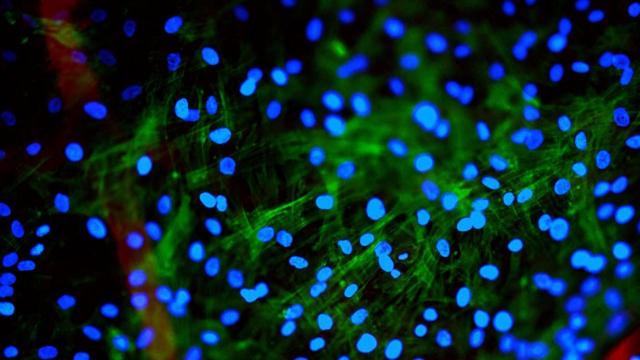New gene editing methods like CRISPR/Cas9 have given scientists unprecedented potential to edit human DNA. But how should researchers in the field actually use these methods, especially when editing traits that can be passed down to children? Should they be used to cure disease? Should they be used to enhance features that aren’t necessary for our survival?
Human mesenchymal stem cells (Image: Rose Spear/Flickr)
We’re definitely far from seeing X-Men mutants and genetically modified superhumans from whatever dystopian young adult novel you may be reading, especially in the United States where lawmakers passed legislation preventing government money from funding this kind of research. That hasn’t stopped researchers in other countries like China from creating gene-edited embryos, which has some scientists very concerned. Today, the US National Academies of Sciences and Medicine released a major new report and recommendations to ensure any such research done in the US in the future is performed responsibly and ethically.
The implicit message is that whether we like it or not, a future of gene-edited humans is on its way.
Although scientists have been able to chop up DNA for decades, precise new tools like CRISPR/Cas9 make it easier than ever to experiment with gene-edited livestock, or use gene-edited cells to help fight cancer in humans, for instance. But CRISPR’s relative ease of use has caused many to worry about the ethical implications of germline editing, or editing traits in cells that could be passed on to later generations. A commentary published in 2015 in Nature warns that gene editing humans could have “unpredictable effects on future generations”.
The new National Academies report is an attempt to offer guidance both for germline editing to cure disease, as well as for enhancement — making stronger, smarter, better humans — should the funding ban in the United States lift.
The Academies’ ruling on germline editing for curing inherited diseases is basically that scientists need to be very careful. The group recommends only permitting such procedures with lots of oversight, so long as researchers don’t have better treatment options, know for a fact the gene they’re editing causes disease, are editing the gene to match the naturally-occurring healthy version and perform rigorous research including clinical trials and multi-generational follow-up studies. After all, they need to ensure they haven’t accidentally introduced some dangerous mutation that will harm future humans.
As far as editing germline cells for human enhancement, the Academies said no way — at least, not yet. They hope to see further public discussion to make sure people are OK with what we might be doing to our species. “I think it’s basically a ‘let’s buy some time,’” director of New York University’s Division of Medical Ethics Arthur Caplan told Gizmodo. “It’s not inappropriate to buy some time. The techniques are new and we don’t know if they’re safe.” Plus, the technology isn’t even close to making superbabies, although that hasn’t stopped ethicists from considering the moral conundrum superbabies pose.
[referenced url=”https://gizmodo.com.au/2017/01/a-new-fertility-technique-could-make-designer-babies-a-reality/” thumb=”https://i.kinja-img.com/gawker-media/image/upload/t_ku-large/d4bxwt936eoll7bjq0sp.jpg” title=”A New Fertility Technique Could Make ‘Designer Babies’ A Reality” excerpt=”Designer babies are the kind of hypothetical conundrum that drive scientists crazy. What if, you ask, it becomes so easy to pick and choose which traits we desire in our children that we wind up creating a class of genetically engineered super humans and basically begin living out a real-life performance of the novel Brave New World? Yeah, what if, most scientists would respond.”]
Caplan was concerned that the report didn’t more strongly recommend testing any potential gene editing procedures in animals first, or discuss who actually owns the rights to various gene editing methods and how much they will cost. “I’m very worried about access,” he said. “Who’s keeping an eye on the prices that will be charged? Will this be another repeat of the drug price problems?”
Ultimately, the Academies and Caplan hope to see more communication between the scientists and the public about how we as a society feel about gene editing. “The reality is the scientific community hasn’t really spent enough resources thinking about how to really engage the public,” said Caplan. “They have to do more surveys, better outreach, use the internet more. The report is quiet about that… We’ve gotta get more creative than we’ve been.”
